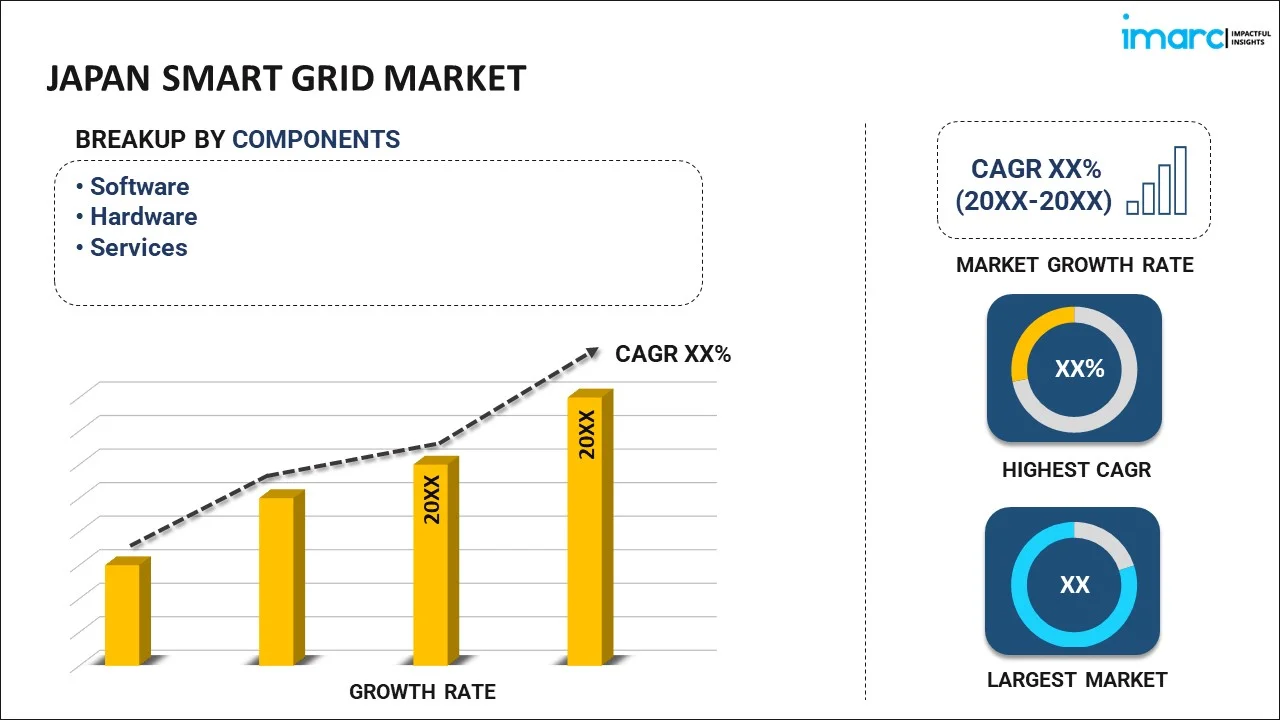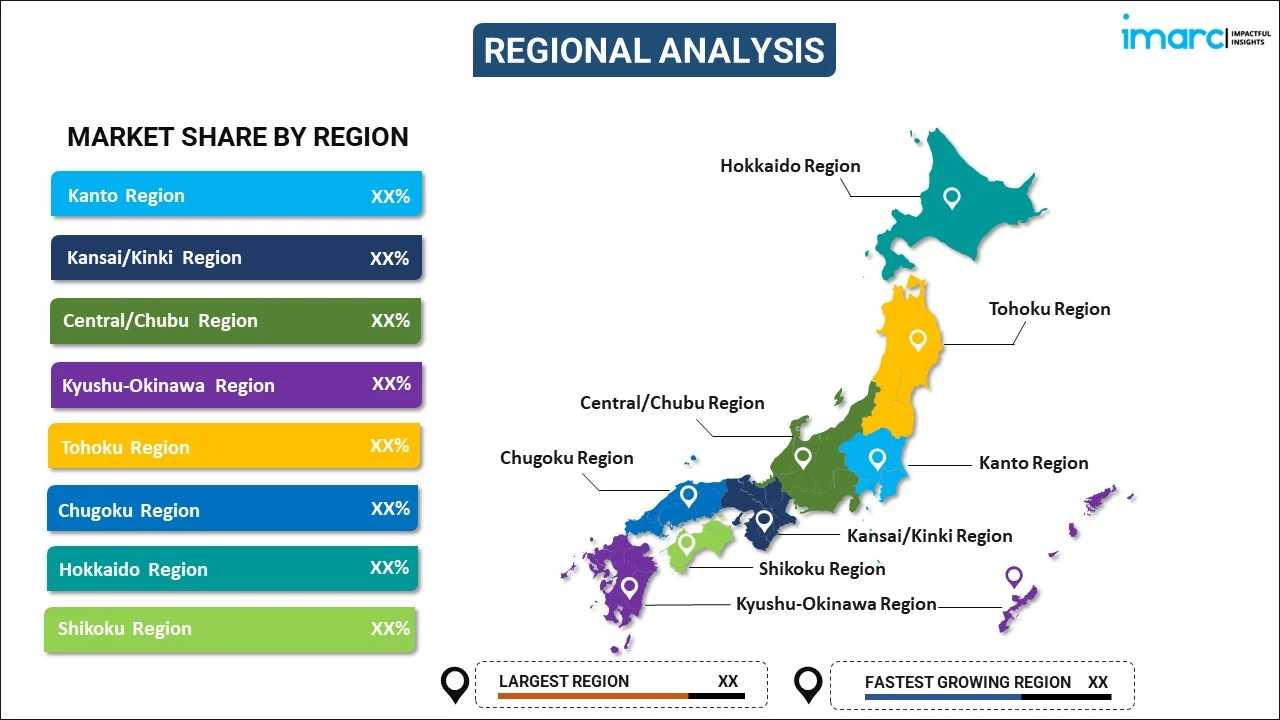
Japan Smart Grid Market Report by Component (Software, Hardware, Services), End User (Residential, Commercial, Industrial), and Region 2025-2033
Market Overview:
Japan smart grid market size reached USD 3.1 Billion in 2024. Looking forward, IMARC Group expects the market to reach USD 10.6 Billion by 2033, exhibiting a growth rate (CAGR) of 13.2% during 2025-2033. The increasing advances in sensors, communication technologies, and data analytics, which have made it more feasible and cost-effective to implement smart grid solutions, are driving the market.
|
Report Attribute
|
Key Statistics
|
|---|---|
|
Base Year
|
2024 |
|
Forecast Years
|
2025-2033
|
|
Historical Years
|
2019-2024
|
| Market Size in 2024 | USD 3.1 Billion |
| Market Forecast in 2033 | USD 10.6 Billion |
| Market Growth Rate (2025-2033) | 13.2% |
A smart grid is an advanced electrical grid system that leverages modern technology to enhance the efficiency, reliability, and sustainability of electricity generation, distribution, and consumption. Unlike traditional grids, smart grids integrate digital communication and control technologies to optimize energy flow. Key features include real-time monitoring and data collection from various sources, such as smart meters and sensors, to provide detailed insights into energy usage patterns. This information allows for more accurate demand forecasting, which, in turn, helps utilities manage supply more efficiently and reduce wastage. Smart grids also support the integration of renewable energy sources like solar and wind power, enabling better grid resilience and reduced greenhouse gas emissions. They offer consumers greater control over their energy usage, enabling them to make informed decisions to save energy and money. Furthermore, in times of outages or emergencies, smart grids can automatically reroute power and isolate affected areas, thereby minimizing disruptions.
Japan Smart Grid Market Trends:
The smart grid market in Japan is experiencing remarkable growth, primarily due to several key drivers that are propelling its expansion. Firstly, the increasing regional demand for electricity, driven by population growth and industrialization, necessitates more efficient energy management systems. Consequently, this demand has prompted utilities and governments to invest in smart grid technologies to enhance grid reliability and reduce energy losses. Moreover, the rising environmental concerns and the urgency to mitigate climate change have encouraged the adoption of renewable energy sources, such as solar and wind. Smart grids facilitate the integration of these intermittent energy sources into the existing grid, making them more reliable and efficient. In addition to this, government initiatives and incentives to reduce carbon emissions have also incentivized the deployment of smart grids. Furthermore, advancements in digital technology and the Internet of Things (IoT) have revolutionized the energy sector. Smart grids leverage these innovations to enable real-time monitoring and control of power distribution, optimizing energy usage and reducing operational costs. As a result, utilities and consumers alike are recognizing the benefits of a more interconnected and intelligent grid system, fostering the smart grid market's rapid growth in Japan.
Japan Smart Grid Market Segmentation:
IMARC Group provides an analysis of the key trends in each segment of the market, along with forecasts at the country level for 2025-2033. Our report has categorized the market based on component and end user.
Component Insights:

- Software
- Advanced Metering Infrastructure
- Smart Grid Distribution Management
- Smart Grid Network Management
- Substation Automation
- Others
- Hardware
- Sensor
- Programmable Logic Controller
- AMI Meter
- Networking Hardware
- Others
- Services
- Consulting
- Support and Maintenance
- Deployment and Integration
The report has provided a detailed breakup and analysis of the market based on the component. This includes software (advanced metering infrastructure, smart grid distribution management, smart grid network management, substation automation, and others), hardware (sensor, programmable logic controller, AMI meter, networking hardware, and others), and services (consulting, support and maintenance, and deployment and integration).
End User Insights:
- Residential
- Commercial
- Industrial
A detailed breakup and analysis of the market based on the end user have also been provided in the report. This includes residential, commercial, and industrial.
Regional Insights:

- Kanto Region
- Kansai/Kinki Region
- Central/ Chubu Region
- Kyushu-Okinawa Region
- Tohoku Region
- Chugoku Region
- Hokkaido Region
- Shikoku Region
The report has also provided a comprehensive analysis of all the major regional markets, which include Kanto Region, Kansai/Kinki Region, Central/ Chubu Region, Kyushu-Okinawa Region, Tohoku Region, Chugoku Region, Hokkaido Region, and Shikoku Region.
Competitive Landscape:
The market research report has also provided a comprehensive analysis of the competitive landscape in the market. Competitive analysis such as market structure, key player positioning, top winning strategies, competitive dashboard, and company evaluation quadrant has been covered in the report. Also, detailed profiles of all major companies have been provided.
Japan Smart Grid Market Report Coverage:
| Report Features | Details |
|---|---|
| Base Year of the Analysis | 2024 |
| Historical Period | 2019-2024 |
| Forecast Period | 2025-2033 |
| Units | Billion USD |
| Scope of the Report | Exploration of Historical Trends and Market Outlook, Industry Catalysts and Challenges, Segment-Wise Historical and Future Market Assessment:
|
| Components Covered |
|
| End Users Covered | Residential, Commercial, Industrial |
| Regions Covered | Kanto Region, Kansai/Kinki Region, Central/ Chubu Region, Kyushu-Okinawa Region, Tohoku Region, Chugoku Region, Hokkaido Region, Shikoku Region |
| Customization Scope | 10% Free Customization |
| Post-Sale Analyst Support | 10-12 Weeks |
| Delivery Format | PDF and Excel through Email (We can also provide the editable version of the report in PPT/Word format on special request) |
Key Questions Answered in This Report:
- How has the Japan smart grid market performed so far and how will it perform in the coming years?
- What has been the impact of COVID-19 on the Japan smart grid market?
- What is the breakup of the Japan smart grid market on the basis of component?
- What is the breakup of the Japan smart grid market on the basis of end user?
- What are the various stages in the value chain of the Japan smart grid market?
- What are the key driving factors and challenges in the Japan smart grid?
- What is the structure of the Japan smart grid market and who are the key players?
- What is the degree of competition in the Japan smart grid market?
Key Benefits for Stakeholders:
- IMARC’s industry report offers a comprehensive quantitative analysis of various market segments, historical and current market trends, market forecasts, and dynamics of the Japan smart grid market from 2019-2033.
- The research report provides the latest information on the market drivers, challenges, and opportunities in the Japan smart grid market.
- Porter's five forces analysis assist stakeholders in assessing the impact of new entrants, competitive rivalry, supplier power, buyer power, and the threat of substitution. It helps stakeholders to analyze the level of competition within the Japan smart grid industry and its attractiveness.
- Competitive landscape allows stakeholders to understand their competitive environment and provides an insight into the current positions of key players in the market.
Need more help?
- Speak to our experienced analysts for insights on the current market scenarios.
- Include additional segments and countries to customize the report as per your requirement.
- Gain an unparalleled competitive advantage in your domain by understanding how to utilize the report and positively impacting your operations and revenue.
- For further assistance, please connect with our analysts.
 Inquire Before Buying
Inquire Before Buying
 Speak to an Analyst
Speak to an Analyst
 Request Brochure
Request Brochure
 Request Customization
Request Customization




.webp)




.webp)












